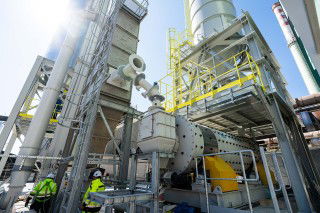Pakistan's construction industry is thriving and is expected to continue doing so in the foreseeable future. However, to maintain healthy capacity utilisation rates, increased exports are needed.
The acceleration in construction sector activity and the government's infrastructure and housing initiatives has seen cement consumption increasing by 17.6 per cent in 2016 to reach 34.7Mt. Growth in the cement sector has been underpinned by robust domestic demand, which has enabled local producers to increase capacity utilisation rates. In the first 10 months (July-April) of FY16-17, the industry delivered 33.8Mt cement, showing overall YoY growth of 6.21 per cent with local consumption rising by 10.74 per cent.
New capacity on the way...
Robust construction activity has led to local cement producers increasing capacity at a break-neck speed. The country’s largest producer, Bestway Cement, informed the Pakistan Stock Exchange in March 2017 that it will set up a brownfield cement plant with a capacity of 6000tpd clinker at its Farooqia site in northern Pakistan. The country’s number two, Lucky Cement, will be expanding the capacity of its Karachi cement works by 1.25Mta in a US$30m project. This is in addition to the proposed plant expansion of 2.3Mta at its works in Punjab province.
Meanwhile, work on DG Khan Cement Co’s US$300m Hub cement plant in Balochistan is progressing well with commissioning scheduled for 2018. Maple Leaf Cement Factory has also confirmed a new, 7300tpd third line at Daud Khel in Iskanderabad. Kohat Cement Ltd (KOHC) is installing a fourth mill to replace old technology at its plant in Kohat, Khyber Pakhtunkhwa. Pioneer Cement Ltd has signed a contract with Sinoma-Chengdu of China for procurement of its new cement works and also plans to undertake brownfield expansion of 2.4Mta, which is expected to cost around PKR24bn. Cherat Cement Factory has announced a third line, yielding expansion of some 2.34Mta. Attock Cement Pakistan Ltd is to install a new facility with a clinker production capacity of 4000tpd (1.2Mta). And earlier this week FLSmidth announced it has signed a large contract to supply Power Cement with a 7700tpd production line.
Exports contract
While domestic demand continues to be encouraging, exports in contrast have been disappointing. Between 2013-16 Pakistani cement exports have fallen by 30 per cent namely due to subdued demand from its largest importer, Afghanistan, and import duties by South Africa and India. Latest data from the All Pakistan Cement Manufacturers Association (APCMA) shows that in the first 10 months of the current fiscal exports were down by 18.63 per cent. Exports from the north declined by 14.42 per cent compared with a fall of 26.19 per cent in the south. To exacerbate the issue, exports of cement from Pakistan via seaports in Karachi have also recently been affected by a two-week strike by goods carriers in mid-May, which brought port traffic to a standstill.
Contrary to the hopes of the APCMA, the government’s 2018 Budget announced last Friday failed to include any relief measures that may help to mitigate the fall in exports. Instead, the Budget proved neutral for the local cement industry with the Pakistan government increasing the allocation for its Public Sector Development Program (PSDP) and reducing corporate tax, while on the other hand increasing Federal Excise Duty.
The APCMA has also been urging the government to put a 20 per cent import duty on Iranian cement, claiming that Iranian producers are "dumping" building material in the border markets
However, going forward Pakistan is now better equipped to reach export markets with the construction of the Pakistan International Bulk Terminal (PIBT). The country’s first dry bulk unit for coal and cement, PIBT started commercial operations with a consignment of coal in early May 2017. The terminal is capable of handling 12Mta of cargo.
Bright prospects
In terms of the sector's overall outlook, the prospects continue to be bright, according to the recently-released Pakistan Economic Survey 2016-17. The outlook remains positive due to the development of housing schemes and increased spending, along with anticipated China-Pakistan Economic Corridor (CPEC)-related projects. Cement consumption in the following years is expected to reach new highs with growth rates for 2017 and 2018 in the upper single-digit range. However, exports are expected to remain muted at just under the 6Mt over the same period.
